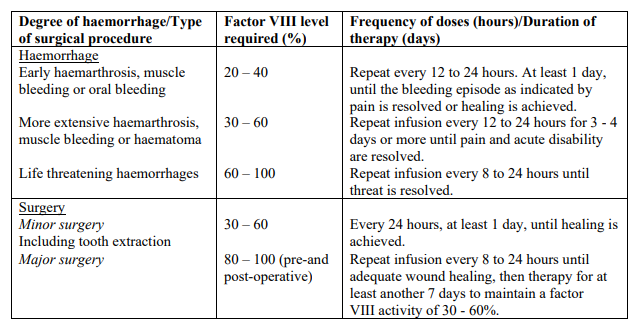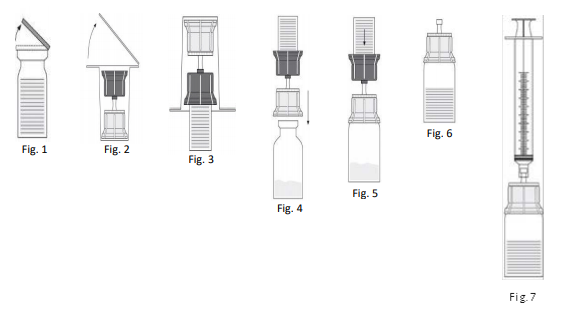Regulatory Information
HSA regulatory responsibility and product classification details
Regulatory Responsibility
Product Classification
Formulation Information
INJECTION, POWDER, FOR SOLUTION
**Dosage and method of administration** Treatment should be initiated under the supervision of a physician experienced in the treatment of haemophilia. Treatment monitoring During the course of treatment, appropriate determination of factor VIII levels is advised to guide the dose to be administered and the frequency of repeated infusions. Individual patients may vary in their response to factor VIII, demonstrating different half-lives and recoveries. Dose based on bodyweight may require adjustment in underweight or overweight patients. In the case of major surgical interventions in particular, precise monitoring of the substitution therapy by means of coagulation analysis (plasma factor VIII activity) is indispensable. When using an in vitro thromboplastin time (aPTT)-based one stage clotting assay for determining factor VIII activity in patients’ blood samples, plasma factor VIII activity results can be significantly affected by both the type of aPTT reagent and the reference standard used in the assay. Also there can be significant discrepancies between assay results obtained by aPTT-based one stage clotting assay and the chromogenic assay according to Ph. Eur. This is of importance particularly when changing the laboratory and/or reagents used in the assay. **Dosage** The dose and duration of the substitution therapy depend on the severity of the factor VIII deficiency, on the location and extent of the bleeding and on the patient's clinical condition. The number of units of factor VIII administered is expressed in International Units (IU), which are related to the current WHO concentrate standard for factor VIII products. Factor VIII activity in plasma is expressed either as a percentage (relative to normal human plasma) or in International Units (relative to an International Standard for factor VIII in plasma). One International Unit (IU) of factor VIII activity is equivalent to that quantity of factor VIII in one ml of normal human plasma. _On demand treatment_ The calculation of the required dose of factor VIII is based on the empirical finding that 1 International Unit (IU) factor VIII per kg body weight raises the plasma factor VIII activity by 1 % to 2 % of normal activity. The required dose is determined using the following formula: **Required Units = body weight (kg) x desired factor VIII rise (%) x 0.5** The amount to be administered and the frequency of administration should always be oriented to the clinical effectiveness in the individual case. In the case of the following haemorrhagic events, the factor VIII activity should not fall below the given plasma activity level (in % of normal) in the corresponding period. The following table can be used to guide dosing in bleeding episodes and surgery:  _Prophylaxis_ For long term prophylaxis against bleeding in patients with severe haemophilia A, the usual doses are 20 to 40 International Unit of factor VIII per kg body weight at intervals of 2 to 3 days. In some cases, especially in younger patients, shorter dosage intervals or higher doses may be necessary. **Method of administration** Intravenous use. It is recommended not to administer more than 2–3 ml Haemoctin SDH/ min. Absolute sterility is to be ensured in all steps of the procedure!  _**Dissolution of the concentrate:**_ - Bring the unopened vials of the solvent (water for injections) and product to room temperature. If a water bath is used for warming, it must be scrupulously ensured that the water does not come into contact with the caps or stoppers of the vials. Otherwise contamination of the medicine may occur. - Remove the caps from both vials in order to expose the central portions of the rubber stoppers. (1). Ensure that the rubber stoppers of the product and solvent vials are treated with a disinfectant. - Remove the top of the transfer system packaging (2). Place the blue part of the transfer system onto the upright standing vial containing the solvent (3). - Remove the remaining part of the packaging of the transfer system. Now the transparent part of the transfer system is visible. - Place the product vial on an even surface. - Turn the combination of transfer system and solvent vial upside down. Push the spike of the transparent part of the adapter straight down through the product vial stopper (4). The vacuum present in the product vial causes the solvent to flow into the product vial. (5) Immediately unscrew the blue part of the transfer system together with the solvent vial. Discard the solvent vial with the blue part of the transfer system attached (6). Gently swirling the product vial helps in dissolving the powder. Do not shake vigorously, all foaming is to be avoided! The solution is clear or slightly opalescent. The solution ready for use should be used immediately after dissolving. Reconstituted medicinal product should be inspected visually for particulate matter and discoloration prior to administration. The solution should be clear or slightly opalescent. Do not use solutions that are cloudy or have deposits. _**Injection:**_ - Once you have dissolved the powder as described above, screw the enclosed syringe with its Luer-Lock connector onto the product vial with the transparent part of the transfer system. (7) This allows you to easily draw the dissolved drug into the syringe. A separate filter is not necessary because the transfer system has its own integral filter. - Carefully disconnect the vial with the transparent part of the transfer system from the syringe. Use the enclosed butterfly needle and administer immediately by slow intravenous injection. The injection rate must not exceed 2 – 3 ml/minute. - After the butterfly needle has been used, it can be made safe with the protective cap.
INTRAVENOUS
Medical Information
**Indications** Treatment and prophylaxis of bleeding in patients with haemophilia A (congenital factor VIII deficiency). This product may be used in the management of acquired factor VIII deficiency. This preparation does not contain von Willebrand factor in pharmacologically effective quantities and is therefore not indicated in von Willebrand's disease.
**Contraindications** Hypersensitivity to the active substance or to any of the excipients.
B02BD02
coagulation factor VIII
Manufacturer Information
GRIFOLS ASIA PACIFIC PTE. LTD.
BIOTEST AG
Active Ingredients
Documents
Package Inserts
Haemoctin SDH For Injection_PI.pdf
Approved: April 1, 2021
